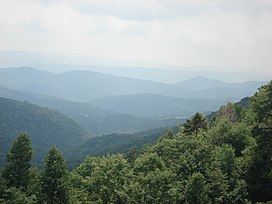Appalachia
Related: About this forumReImagine Appalachia: Coalition Plan To Build A Better Future For Appalachia, Economy & Environment

PennFuture. ReImagine Appalachia was born out of a broad recognition that the economy has not been working for most people and places in the Ohio River Valley. In response, a diverse set of economic, environmental and community leaders, and grassroots organizations, came together to find common ground and build the future we want to see—a 21st century economy that’s good for workers, communities, and the environment.
ReImagine Appalachia is a broad and inclusive coalition of individuals and organizations based in Appalachia, specifically in Pennsylvania, Ohio, West Virginia and Kentucky. As part of this coalition, PennFuture helped to craft a blueprint to amplify voices to expand economic opportunity and reduce our greenhouse gases. Now is the time to come together and reimagine a 21st century economy for the Ohio Valley that’s good for workers, communities, and the environment. The coalition’s policy blueprint, released on July 21, has three guiding principles. Read the entire blueprint by clicking here.
- Expand opportunity through public investments: This blueprint calls on policymakers to maximize good union jobs, ensure access to union jobs for Black, Indigenous, women and low-wage workers, and ensure the community benefits from federal investments via public input and community oversight.
- Build a 21st Century sustainable Appalachia: In addition, the blueprint demands for officials to restore our damaged lands and waters, build a sustainable transportation system and create new jobs for transit workers, revive the Civilian Conservation Corps, modernize the electric grid, and grow manufacturing by making it cleaner and more efficient while also making Appalachia a hub for electric vehicle production and alternatives to single-use plastic.
- Rebuild the middle class: Finally, the blueprint advocates for union rights, better pay, benefits and local ownership models for working people across all industries in the region.
The report is also calling on officials to repair the damage done to Appalachia over the last century. This includes enacting policies that will clean up abandoned properties and put them back to good use, like repurposing shuttered coal-fired power plants into eco-industrial parks that utilize circular manufacturing. In addition, we are calling on officials to provide health care and secure pensions for coal workers, especially those with black lung disease...
- More, https://www.pennfuture.org/ReImagineAppalachia
_____
https://truthout.org/articles/organizers-in-appalachia-are-building-a-green-new-deal-blueprint-for-themselves/
As you know, the Ohio River Valley of Appalachia, also known as coal country, has long been a political stumbling block to national climate and clean energy solutions. No longer. Appalachia is now at the table of the national conversation. We know what we want and need. ReImagine Appalachia is advancing the vision of a 21st century economy for the Ohio Valley. Can you talk about the principles and aims guiding this vision? ReImagine Appalachia is a collection of hundreds of stakeholder groups working across the Ohio River Valley states of Appalachia — Ohio, Pennsylvania, West Virginia and Kentucky. We came together to create a collective vision of what a 21st century sustainable Appalachia looks like, and to build out the roadmap for how we get from where we are to where we need to go.
It is important to understand that Appalachia is essentially an area of concentrated poverty. The region has been exploited for more than a century by absentee corporations in the extractive industries — exploiting our workers, damaging our lands, and leaving our workers and neighbors sick. With the abundance of natural resources in the lands of coal country, one would think we would be the richest region in the nation. But we are not. We are the poorest. Too many of the region’s counties rank in the bottom 10 percent nationally for their high level of unemployment and poverty, and low family incomes. The region is poor, and it isn’t going to lift itself up by its collective bootstrings.
National climate solutions, if Appalachia is at the table, can be an opportunity to secure much needed and deserved resources for the region. Appalachia literally powered the prosperity of the rest of the nation, while the region itself was left in poverty. We believe the region is owed its due share of climate infrastructure resources. The people of Appalachia want everything everyone else wants — a modern electric grid in Appalachia that doesn’t lose power every time it rains hard; universal, quality broadband affordable to everyone so the kids can use computers without going to the library and parents can work remotely; to grow clean and efficient manufacturing in the region with equivalent jobs to those found in the coal industry; and, to build out a sustainable transportation network that includes an Appalachian rail corridor. Perhaps more importantly, we want the good union jobs that can come with these investments. These infrastructure investments can put the region’s residents to work building the future they want to live in...
_____
https://en.wikipedia.org/wiki/Appalachian_Mountains
NBachers
(19,131 posts)appalachiablue
(43,793 posts).. Why tunnels?: A former World War Two air-raid shelter 100ft (30.5m) under Clapham Common, London, is already being used to grow greens for local supermarkets and restaurants.
> Unlike current agriculture, farming underground is unaffected by irregular seasons, climate change and the extreme weather witnessed throughout 2018.
Almost all the ingredients needed for growing crops such as lettuces, carrots, mushrooms and strawberries are already in place.
The air temperature and humidity levels are generally temperate and constant while there is a ready water supply as well as carbon dioxide.
"Tunnels and shafts would need less energy with heating, so are very attractive for food production. They're almost perfect," said Prof Riffat.
NBachers
(19,131 posts)appalachiablue
(43,793 posts)A former World War Two air-raid shelter 100ft (30.5m) under Clapham Common, London, is already being used to grow greens for local supermarkets and restaurants.